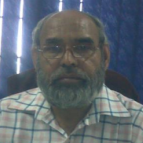
Syed Naseem Ahmad
Work place: Dept. of Electronics & Communication Engineering, Jamia Millia Islamia,New Delhi-110025, India
E-mail: snahmad@jmi.ac.in
Website:
Research Interests: Computational Science and Engineering, Computer systems and computational processes, Image Manipulation, Image Processing
Biography
Dr. Syed Naseem Ahmad is currentily working as a Head of Department (ECE) in Jamia Milia Islamia University Jamia Nagar India; New Delhi-110025. He did bachelor in electrical engineering in 1975 from Aligarh Muslim University. He did his M.Tech degree from the same university in Instrumentation and Control engineering in 1978. He has done PhD from JMI. He has wide area of research ranging from Analog Signal Processing, Image processing and communication engineering. He has guided many research fellows. He has worked as a reviewer for several conferences and Journals both national and international. He is author of more than 50 scientific contributions including articles in international refereed Journals and Conferences.
Author Articles
Smart PCS Based System for Oxygen Content Measurement
By Vaibhav Bhatia Pawan Whig Syed Naseem Ahmad
DOI: https://doi.org/10.5815/ijitcs.2015.06.06, Pub. Date: 8 May 2015
This paper presents the performance analysis of smart PCS based system for an accurate oxygen content measurement in the aqueous electrolyte solution. The system intends to measure the photo catalytic activity of the PCS which is sensitive to O2 by integrating the software and hardware design technique for more accurate results. The threshold voltage of the PCS changes due to photo catalysis process causing fluctuations in the PCS readout which is sensed by the microcontroller via an inbuilt 10 bit A/D converter. The digitized signal is processed and converted into corresponding value of O2 content. The proposed digital system is fast as compared to conventional flow injection analysis which is tiresome and time consuming job. The approach for this system relies on the fast operation of PCS which operates under sub threshold conditions and reduced computation time. The system is more user friendly and the outcomes of simulation are fairly in agreement with the theoretical estimations. The system is highly favourable for water quality monitoring applications due to reduced response time.
[...] Read more.Performance Analysis of Various Readout Circuits for Monitoring Quality of Water Using Analog Integrated Circuits
By Pawan Whig Syed Naseem Ahmad
DOI: https://doi.org/10.5815/ijisa.2012.11.11, Pub. Date: 8 Oct. 2012
This paper presents a comparative performance study of various analog integrated circuits (namely CC-II, DVCC, CDBA and CDTA) used with ISFET for monitoring the quality of water. The use of these active components makes the implementation simple and attractive. The functionality of the circuits are tested using Tanner simulator version 15 for a 70nm CMOS process model also the transfer functions realization for each is done on MATLAB R2011a version, the Very high speed integrated circuit Hardware description language(VHDL) code for all scheme is simulated on Xilinx ISE 10.1 and various simulation results are obtained and its is found that DVCC is most stable and consume maximum power whereas CC-II is the least stable and consumes minimum power amongst all the four deployed analog IC’s. Detailed simulation results are included in the paper to give insight into the research work carried out.
[...] Read more.Other Articles
Subscribe to receive issue release notifications and newsletters from MECS Press journals